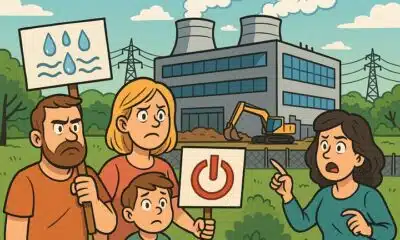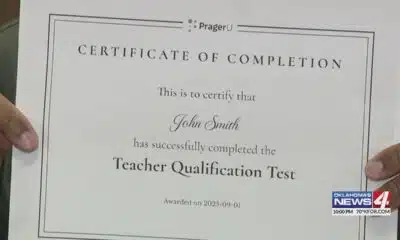News from the South - Louisiana News Feed
Jefferson Parish StormPrep 2025 event prepares residents for hurricane season
SUMMARY: The 2025 hurricane season starts June 1, and Jefferson Parish officials urge residents to prepare thoroughly. Parish President Cynthia Lee Sheng emphasizes the need for family discussions and having an evacuation plan due to the area’s vulnerability. Forty local vendors offered resources on storm readiness, with Home Builders Association CEO Dan Mills advising actions like trimming branches and clearing storm drains to reduce damage. Residents should stock essentials such as water, food, prescriptions, and batteries. Generator owner Craig Jacomine warns against last-minute repairs, recommending monthly checks. Officials also stress maintaining adequate home insurance as the season begins.
The post Jefferson Parish StormPrep 2025 event prepares residents for hurricane season appeared first on wgno.com
News from the South - Louisiana News Feed
Arrests, recoveries made during state-wide operations tackling sex offenders, missing children
SUMMARY: The U.S. Marshals Office, partnering with multiple local and federal agencies, conducted two operations from May to August targeting missing children and sexual offenders in New Orleans. The NO Saint and Sinners operation and Operation Fresh Start resulted in over 65 felony arrests, including 26 sex-based charges involving children, 15 sex offender registration violations, and seven child abuse warrants. Fifteen missing or endangered children were recovered. Notable arrests included suspects wanted for child pornography, trafficking, and violent crimes. The operations were supported by resources from the USMS Sex Offender Investigations Branch and involved collaboration with Crimestoppers and other law enforcement agencies to enforce justice and protect vulnerable victims.
Read the full article
The post Arrests, recoveries made during state-wide operations tackling sex offenders, missing children appeared first on wgno.com
News from the South - Louisiana News Feed
Lafayette prosecutor Gary Haynes’ federal bribery trial starts
SUMMARY: Gary Haynes, longtime Lafayette Assistant District Attorney, faces federal trial Monday on bribery, kickback, money laundering, and obstruction charges linked to the 15th Judicial District Attorney’s Office pretrial intervention program. Indicted in September, Haynes allegedly steered participants to a vendor in exchange for bribes, including an $81,000 truck. Co-conspirators, all pleading guilty, are expected to testify against him. Evidence includes wiretaps and consensual recordings. Haynes remains on unpaid administrative leave amid scrutiny for rehiring him after a decade-old bribery scandal shuttered the office. The trial poses significant reputational and legal consequences, with Haynes facing up to 60 years if convicted.
The post Lafayette prosecutor Gary Haynes’ federal bribery trial starts appeared first on thecurrentla.com
News from the South - Louisiana News Feed
Many Black, Latino people can’t get opioid addiction med. Medicaid cuts may make it harder.
by Nada Hassanein, Louisiana Illuminator
September 8, 2025
Pharmacies in Black and Latino neighborhoods are less likely to dispense buprenorphine — one of the main treatments for opioid use disorder — even though people of color are more likely to die from opioid overdoses.
The drug helps reduce cravings for opioids and the likelihood of a fatal overdose.
While the nation as a whole has seen decreases in opioid overdose deaths in recent years, overdose deaths among Black, Latino and Indigenous people have continued to increase.
Many medical and health policy experts fear the broad domestic policy law President Donald Trump signed in July will worsen the problem by increasing the number of people without health insurance. As a result of the law, the number of people without coverage will increase by about 10 million by 2034, according to the Congressional Budget Office.
About 7.5 million of the people who will lose coverage under the new law are covered by Medicaid. Shortly before Trump signed the bill into law, researchers from the University of Pennsylvania and Boston University estimated that roughly 156,000 Medicaid recipients will lose access to medications for opioid addiction because of the cuts, resulting in approximately 1,000 more overdose deaths annually.
Because Black and Hispanic people are overrepresented on the rolls, the Medicaid cuts will have a disproportionate effect on communities that already face higher barriers to getting medications to treat addiction.
From 2017 to 2023, the percentage of U.S. retail pharmacies regularly dispensing buprenorphine increased from 33% to 39%, according to a study published last week in Health Affairs.
But researchers found the drug was much less likely to be available in pharmacies in mostly Black (18% of pharmacies) and Hispanic neighborhoods (17%), compared with mostly white ones (46%).
In some states, the disparity was even worse. In California, for example, only about 9% of pharmacies in Black neighborhoods dispensed buprenorphine, compared with 52% in white neighborhoods.
The researchers found buprenorphine was least available in Black and Latino neighborhoods across nearly all states.
Barriers to treatment
Dr. Rebecca Trotzky-Sirr, a family physician who specializes in addiction medicine, said many communities of color are “pharmacy deserts.” Even the pharmacies that do exist in those neighborhoods tend to “have additional barriers to obtain buprenorphine and other controlled substances out of a concern for historic overuse of some treatments,” said Trotzky-Sirr, who wasn’t involved in the study.
In addition to its federal classification as a controlled substance, buprenorphine is also subject to state regulations to prevent illegal use. Pharmacies that carry it know that wholesalers and distributors audit their orders, which dissuades some from stocking or dispensing it.
Dima Qato, associate professor of clinical pharmacy at the University of Southern California and an author of the Health Affairs study, said that without changes in policy, Black and Hispanic people will continue to have an especially hard time getting buprenorphine.
“If you don’t address these dispensing regulations, or regulate buprenorphine from the aspect of pharmacy regulations, people are still going to encounter barriers accessing it,” she said.
In neighborhoods where at least a fifth of the population is on Medicaid, just 35% of pharmacies dispensed buprenorphine, Qato and her team found. But in neighborhoods with fewer residents on Medicaid, about 42% of pharmacies carried the drug.
Medicaid covers nearly half — 47% — of nonelderly adults who suffer from opioid use disorder. In states that expanded Medicaid under the Affordable Care Act, another recent study found an increase in people getting prescriptions for buprenorphine.
“Medicaid is the backbone of care for people struggling with opioid use disorder,” said Cherlette McCullough, a Florida-based mental health therapist. “We’re going to see people in relapse. We’re going to see more overdoses. We’re going to see more people in the ER.”
Qato said the shortage of pharmacies in minority communities is likely to get worse, as many independent pharmacists are already struggling to stay open.
“We know they’re more likely to close in neighborhoods of color, so there’s going to be even fewer pharmacies that carry it in the neighborhoods that really need it,” she said.
‘There needs to be urgency’
Qato and her colleagues say states and local governments should mandate that pharmacies carry a minimum stock of buprenorphine and dispense it to anyone coming in with a legitimate prescription. As examples, they point to a Philadelphia ordinance mandating that pharmacies carry the opioid overdose-reversal drug naloxone and similar emergency contraception requirements in Massachusetts.
“We need to create expectations. We need to encourage our pharmacies to carry this to make it accessible, same day, and there needs to be urgency,” said Arianna Campbell, a physician assistant and co-founder of the Bridge Center, a California-based organization that aims to help increase addiction treatment in emergency rooms.
“In many of the conversations I have with pharmacies, when I’m getting some pushback, I have to say: ‘Hey, this person’s at the highest risk of dying right now. They need this medication right now.’”
She said patients frequently become discouraged due to barriers they face in getting prescriptions filled. The Bridge Center has been expanding its patient navigator program across the state, and helping other states start their own. The program helps patients identify pharmacies where they can fill their prescription fastest.
“There’s a medication that can help you, but at every turn it’s really hard to get it,” she said, calling the disparities in access to medication treatment “unacceptable.”
Trotzky-Sirr, the California doctor, fears the looming Medicaid cuts will cause many of her patients to discontinue treatment and relapse. Many of her patients are covered by Medi-Cal, the state’s Medicaid program.
“A lot of our patients are able to obtain medications for treatment of addiction like buprenorphine, because of the state covering the cost of the medication,” said Trotzky-Sirr, who also is a regional coordinator at the Bridge Center.
“They don’t have the resources to pay for it, cash, out of pocket.”
Some low-income patients switch between multiple providers or clinics as they try to find care and coverage, she added. These could be interpreted as red flags to a pharmacy.
Trotzky-Sirr argued buprenorphine does not need to be monitored as carefully as opioids and other drugs that are easier to misuse or overuse.
“Buprenorphine does not have those features and really needs to be in a class by itself,” she said. “Unfortunately, it’s hard to explain that to a pharmacist in 30 seconds over the phone.”
More is known about the medication now than when it was placed on the controlled substances list about two decades ago, said Brendan Saloner, a Bloomberg Professor of American Health in Addiction and Overdose at Johns Hopkins University.
Pharmacies are fearful of regulatory scrutiny and don’t have “countervailing pressure” to ensure patients get the treatments, he said.
On top of that fear, Medicaid managed care plans’ prior authorization processes may also be adding to the pharmacy bottleneck, he said.
“Black and Latino communities have higher rates of Medicaid enrollment, so to the extent that Medicaid prior authorization techniques are a hassle to pharmacies, that may also kind of discourage them [pharmacies] from stocking buprenorphine,” he said.
In some states, buprenorphine is much more readily available. In Maine, New Hampshire, Oregon, Rhode Island, Utah and Vermont, more than 70% of pharmacies carried the drug, according to the study. Buprenorphine availability was highest in states such as Oregon that have the least restrictive regulations for dispensing it.
In contrast, less than a quarter of pharmacies in Iowa, North Dakota, Texas, Virginia and Washington, D.C., carried the medication.
“We’re going to see more people becoming unhoused, because without treatment, they’re going to go back to those old habits,” McCullough, the Florida therapist, said. “When we talk about marginalized communities, these are the populations that are going to suffer the most because they already have challenges with access to care.”
Stateline reporter Nada Hassanein can be reached at nhassanein@stateline.org.
This story was originally produced by Stateline, which is part of States Newsroom, a nonprofit news network which includes Louisiana Illuminator, and is supported by grants and a coalition of donors as a 501c(3) public charity.
Louisiana Illuminator is part of States Newsroom, a nonprofit news network supported by grants and a coalition of donors as a 501c(3) public charity. Louisiana Illuminator maintains editorial independence. Contact Editor Greg LaRose for questions: info@lailluminator.com.
The post Many Black, Latino people can’t get opioid addiction med. Medicaid cuts may make it harder. appeared first on lailluminator.com
Note: The following A.I. based commentary is not part of the original article, reproduced above, but is offered in the hopes that it will promote greater media literacy and critical thinking, by making any potential bias more visible to the reader –Staff Editor.
Political Bias Rating: Center-Left
This content addresses systemic inequalities in healthcare access, particularly for Black and Latino communities, and critiques recent policy changes associated with a Republican administration that may worsen these disparities. The focus on racial and socioeconomic disparities, Medicaid cuts, and calls for government intervention aligns with a center-left perspective that emphasizes social justice, equity in healthcare, and the importance of public programs. While the article is rooted in data and expert analysis, its framing critiques conservative policy impacts and supports regulatory solutions, typical of center-left discourse.
-
News from the South - Tennessee News Feed6 days ago
Tennessee ranks near the top for ICE arrests
-
Mississippi Today6 days ago
Trump proposed getting rid of FEMA, but his review council seems focused on reforming the agency
-
Mississippi Today5 days ago
Brandon residents want answers, guarantees about data center
-
News from the South - Texas News Feed4 days ago
Texas high school football scores for Thursday, Sept. 4
-
News from the South - Arkansas News Feed7 days ago
Every fall there’s a government shutdown warning. This time it could happen.
-
News from the South - Oklahoma News Feed7 days ago
Test taker finds it's impossible to fail 'woke' teacher assessment
-
The Conversation7 days ago
What is AI slop? A technologist explains this new and largely unwelcome form of online content
-
News from the South - Arkansas News Feed6 days ago
Hackett student arrested after shooting threat












































